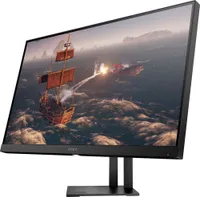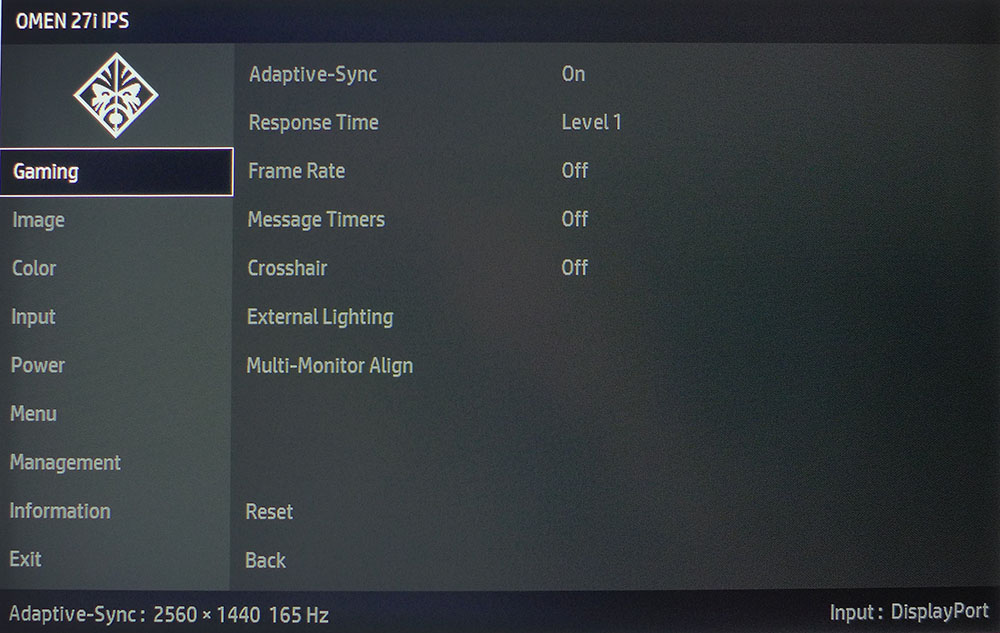Tom's Hardware Verdict
Though it omits HDR, the HP Omen 27i delivers what's needed for a great gaming experience. With premium quality color, a 165 Hz refresh rate, Adaptive-Sync and low input lag, it can serve casual and competitive players. High-end build quality and styling make it ideal for any desktop.
Pros
- +
Color saturation and accuracy
- +
Low input lag
- +
165 Hz refresh rate
- +
FreeSync & G-Sync
- +
Styling and build quality
Cons
- -
Average native contrast for price
- -
No sRGB mode
Why you can trust Tom's Hardware
Cyber Monday Deal for the HP Omen 27i
HP Omen 27i: was $509, now $349 at Best Buy (save $160)
With its IPS display, 165 Hz refresh rate, and 1440p resolution, this 27-inch display is a great choice for gamers and content creators.
Though the best gaming monitors come in many shapes and sizes, the flat, 27-inch panel is one of the most popular. With 1440p (2560 x 1440)resolution, a 27-incher offers good pixel density (109ppi) and responsive performance with mid-range graphics cards. You won’t need a bleeding-edge system to drive frame rates past 100 frames per second (fps). And in today’s market, it’s not difficult to find such a screen for under $500.
HP’s Omen line of gaming displays offer premium performance, accurate color and high-end build quality. The HP Omen 27i (usually selling for $460-$500) in question is an IPS panel with a fast 165 Hz refresh rate, both FreeSync and G-Sync Compatibility and an expanded color gamut. Color purists may be disappointed, but there's a myriad of features for gamers. The Omen 27i isn’t the cheapest 27-inch panel out there but offers a lot for the money. With performance to match, it’s a compelling choice.
HP Omen 27i Specifications
| Panel Type & Backlight | Nano IPS / W-LED, edge array |
|---|---|
| Screen Size / Aspect Ratio | 27 inches / 16:9 |
| Max Resolution & Refresh | 2560x1440 @ 165Hz, FreeSync, G-Sync Compatible, 48-165 Hz |
| Native Color Depth & Gamut | 10-bit / DCI-P3 |
| Response Time (GTG) | 1ms |
| Brightness | 350 nits |
| Contrast | 1,000:1 |
| Speakers | None |
| Video Inputs | 1x DisplayPort 1.2, 1x HDMI 2.0 |
| Audio | 3.5mm headphone output |
| USB 3.0 | 1x up, 2x down |
| Power Consumption | 28.5w, brightness @ 200 nits |
| Panel Dimensions (WxHxD w/base) | 24.1 x 15.5-20.5 x 10.1 inches (612 x 394-521 x 257mm) |
| Panel Thickness | 2.6 inches (66mm) |
| Bezel Width | Top/sides: 0.3 inch (8mm); Bottom: 0.9 inch (23mm) |
| Weight | 17.1 pounds (7.8kg) |
| Warranty | 1 year |
Features
HP doesn’t skimp on the panel used in the Omen 27i. It’s a brand-new part from LG called Nano IPS. This doesn’t mean the backlight is quantum dot, but it does mean a very wide gamut with accurate color. Our tests showed DCI-P3 coverage that ranks it above most of the extended color monitors we’ve reviewed. The backlight is a white LED with a rated output of 350 nits. HDR is not supported, but the Omen 27i has a native color depth of 10 bits. If you see banding on this screen, it’s coming from the content, not the 27i.
Adaptive-Sync comes in both flavors with a G-Sync Compatible certification from Nvidia, as well as AMD FreeSync support. The 165 Hz refresh rate is achieved without overclocking. This is one quick panel, as we discovered in our tests.
Though on-screen display (OSD) navigation is easy with a joystick, HP offers a convenient Windows 10 app called Omen Command Center that controls every monitor function from your PC. It even includes a crosshair editor so you can tailor the aiming point to your personal preference and controls lighting for all connected Omen products, like gaming PCs and gaming laptops.
Assembly and Accessories
Unpacking the Omen 27i reveals a base and upright already assembled. Further investigation uncovers a small Allen key. You’ll need it to attach the panel to the stand with two captive bolts. Once complete, the package is super solid and though the base looks small, its diamond shape ensures stability with a minimal desktop footprint. Accessories include DisplayPort and USB cables with a small external power supply.
Get Tom's Hardware's best news and in-depth reviews, straight to your inbox.
Product 360

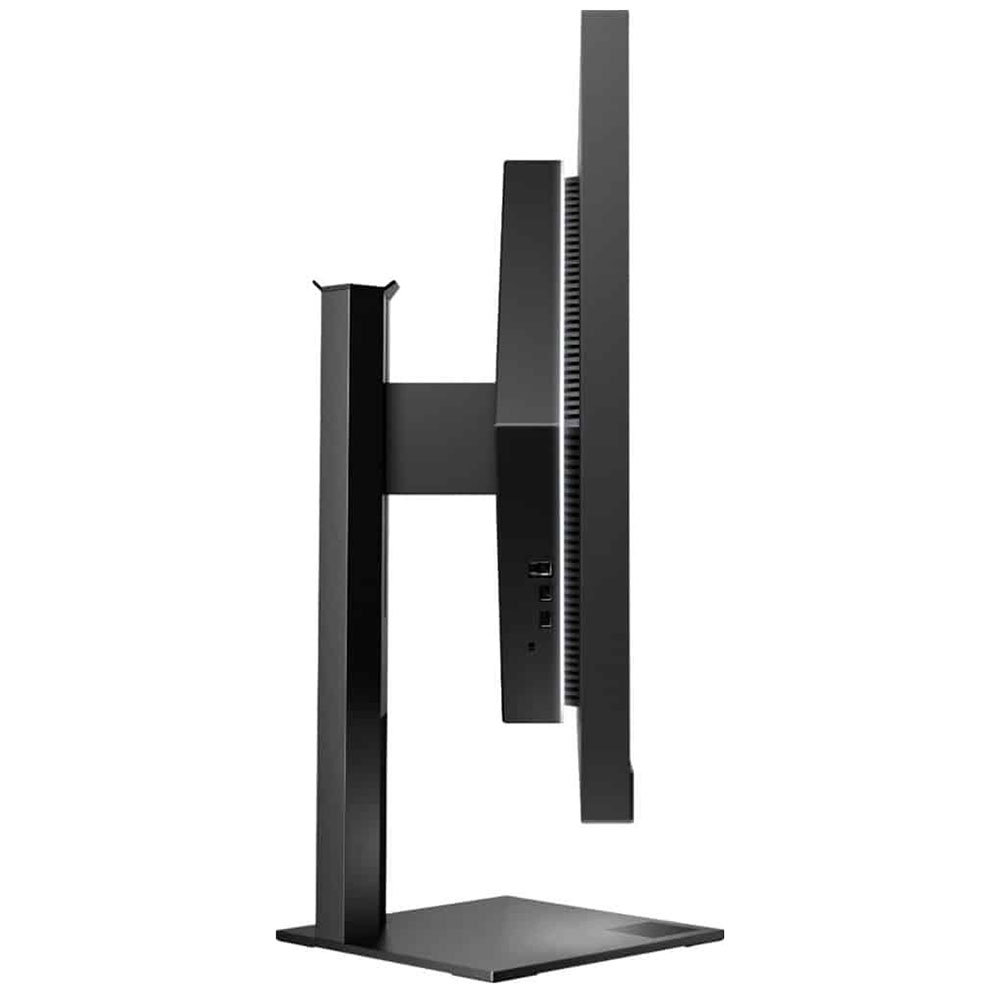
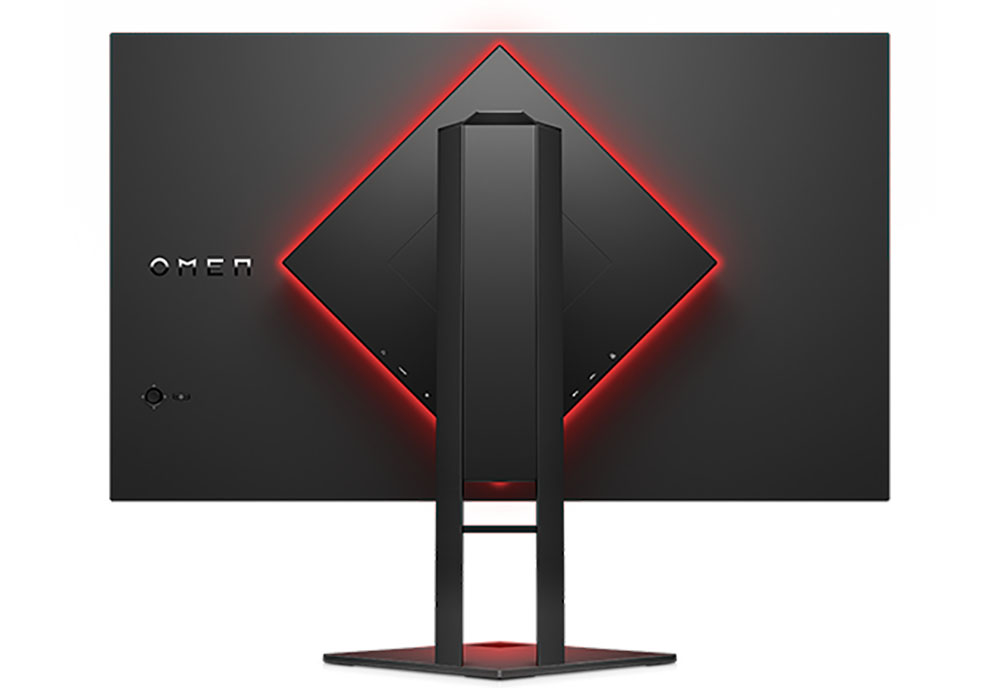
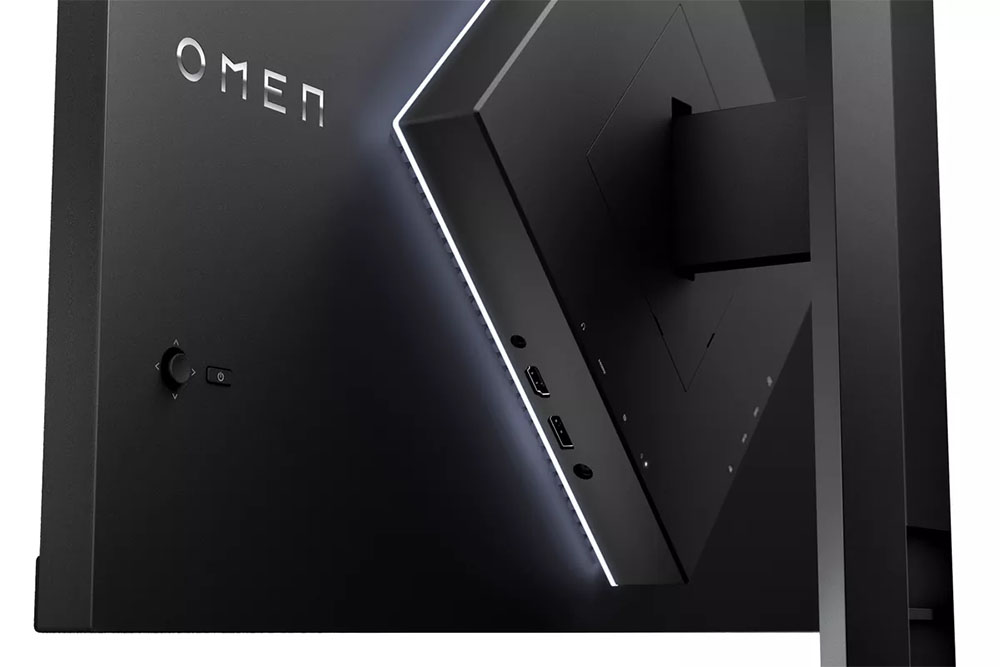
We’ve never seen an HP Omen display that didn’t have premium build quality, and the Omen 27i is no exception. The chassis has monolithic styling with satin-finished metal parts and a rock-solid stand. LED lighting is on the back and below the bezel with a variety of colors and effects to choose from.
The Omen 27i’s styling is all about the diamond shape; you won’t find a single curve. Edges are nicely softened, but everything comes together with straight lines and right angles. The stand is wobble-free with nary a hint of play. It offers a 5-inch height adjustment and -5/20-degree tilt. There is no swivel function, but upright’s top is ideally shaped for hanging a pair of headphones.
The screen features a flush-mounted anti-glare layer of 3H hardness. The bezel is 8mm around the top and sides with a 23mm strip trimming the bottom. The Omen logo is printed front and center, and a small LED underneath brings RGB lighting to your desktop with any color of RGB and a variety of effects. You control RGB from the OSD and HP’s Omen Command Center PC app.
From the side, the Omen 27i appears to be built from blocks. Internal components are housed in a diamond-shaped bulge rimmed by LEDs. This allows ports to be placed where they're visible and easily accessible. Video inputs include a DisplayPort 1.2 input and HDMI 2.0 (for a comparison between the two see our DisplayPort vs. HDMI article). A 3.5mm headphone jack shares one side with those ports, and three USB 3.0 ports, one up and two downstream, are on the other. You can loop the cables through the stand to keep things tidy.
OSD Features
The OSD is all business with an Omen logo to remind one of the 27i’s gaming intent. It’s divided into eight sub-menus, each with its own reset function.
All the gaming features are grouped in the Gaming sub-menu. You can toggle Adaptive-Sync, adjust the overdrive (four levels) and put elements on the screen like crosshairs, frame counters and timers. You can also control the lighting effects here and use alignment marks for multi-screen setups.
The Image menu has the Omen 27i’s luminance controls, and the Color menu has the other necessary calibration options. Color is very accurate out of the box, though some tweaks to grayscale tracking are necessary for maximum quality. There are eight picture modes, all of which allow changes to the RGB values. The only thing missing are gamma presets. The 27i tracks 2.2 pretty well, but some might prefer a darker or lighter luminance curve.
Other convenience functions include options for programming the OSD joystick to quickly access things like input selection and brightness. Power can be managed with auto-off or no-signal timers, and you can shut off the power LED if you wish.
HP Omen 27i Calibration Settings
The Omen 27i comes set to Standard mode, which covers the DCI-P3 color gamut accurately with good gamma tracking but a slightly green white point. You can easily fix the latter by adjusting the RGB sliders, which we did to excellent effect.
Once tweaked, this is a very accurate monitor. There is no sRGB mode, so you’ll be seeing the expanded color gamut with all content. As stated earlier, there is no HDR support.
Below are our recommended calibration settings for the Open 27i.
| Picture Mode | Standard | Row 0 - Cell 2 |
| Brightness 200 nits | 51 | Row 1 - Cell 2 |
| Brightness 120 nits | 25 | Row 2 - Cell 2 |
| Brightness 100 nits | 19 | Row 3 - Cell 2 |
| Brightness 80 nits | 13 | Row 4 - Cell 2 |
| Brightness 50 nits | 4 (minimum 39 nits) | Row 5 - Cell 2 |
| Contrast | 78 | Row 6 - Cell 2 |
| RGB Gain Control | Red 252, Green 242, Blue 252 | Row 7 - Cell 2 |
Gaming and Hands-on
The Omen 27i is a very versatile monitor. It was equally at home playing games with demanding graphics or pushing through workday tasks. 27 inches and 109ppi is an ideal balance of sharpness and performance. The large color gamut was apparent in everything we did, from Windows desktop background photos to movies and games of all types.
Windows instantly recognized the Omen 27i’s 165 Hz refresh and G-Sync Compatibility. No changes were necessary in the Nvidia Control panel. FreeSync also worked right off the bat when we hooked the monitor up to our AMD-based gaming PC.
We calibrated (see our recommended settings above) before starting the hands-on tests. The Standard picture mode provided excellent color and spot-on grayscale tracking after a few tweaks to the RGB sliders.
Small text and icons were easy to discern on a variety of contrasting backgrounds with the Open 27i.Black text on white came across clearly. We tried the dynamic contrast function and found it helped deepen the image a little for tasks like word processing, spreadsheet editing and photo work. It appears that feature has no downside when viewing real-world content.
Watching movies was also a pleasure on the Omen 27i. Some Blu-ray films might look a tad overblown, since the color gamut is too large. Most streamed material is also meant for the smaller Rec.709 color space. But this was a minor issue.
Gaming is where the Omen 27i shines. Tomb Raider came across with rich and vibrant hues as we played in an outdoor beach environment. Moving into dark caves changed the feel to dark and foreboding, as it should. With dynamic contrast engaged, shadow detail still popped, and highlights popped even more. With dynamic contrast turned off, the 27i looked like a typical IPS monitor with blacks that aren’t quite black. HP has done an excellent job with its dynamic contrast feature, which works better than what we’ve seen from any other non-HDR monitor.
Call of Duty WWII is our usual HDR test, but it looks pretty good in SDR mode too when there is this much color available. Urban rubble showed its rough textures, fine shades of gray and earth tones. Smoke and mist effects were smooth and clean without banding or artifacts. Small bits of color from uniforms shone nicely.
Regardless of the game, video processing is among the best we’ve seen. Frame rates stayed between 140 and 160 fps on both our Nvidia and AMD-equipped PCs. Frame tears were completely non-existent, and nput lag was also imperceptible. Measured differences of a few milliseconds might seem insignificant, but it makes a visible difference. We were able to play longer and more comfortably on the Omen 27i than many other gaming monitors. In our experience, the frame rate can never be too high nor can input lag ever be too low. The Omen 27i delivers performance worthy of competitive gaming at the professional level.

Christian Eberle is a Contributing Editor for Tom's Hardware US. He's a veteran reviewer of A/V equipment, specializing in monitors. Christian began his obsession with tech when he built his first PC in 1991, a 286 running DOS 3.0 at a blazing 12MHz. In 2006, he undertook training from the Imaging Science Foundation in video calibration and testing and thus started a passion for precise imaging that persists to this day. He is also a professional musician with a degree from the New England Conservatory as a classical bassoonist which he used to good effect as a performer with the West Point Army Band from 1987 to 2013. He enjoys watching movies and listening to high-end audio in his custom-built home theater and can be seen riding trails near his home on a race-ready ICE VTX recumbent trike. Christian enjoys the endless summer in Florida where he lives with his wife and Chihuahua and plays with orchestras around the state.
-
gg83 Why only 350 nits? That seems low for the price to me. Nano-ips has better color, not brightness?Reply
